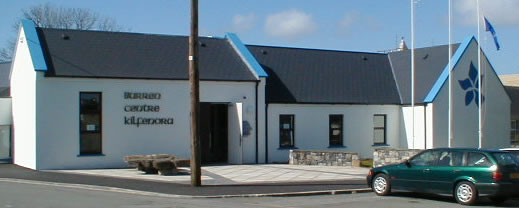The Burren Centre...
The Burren Centre offers the visitor a first class experience with their "must see exhibition", a spacious gift shop, and a homely country style tea room.
The Burren with its innate sense of spiritual peace has an extraordinary array of flora and wildlife, megalithic tombs and monuments older than Egypt's pyramids. This story is excitingly captured and impressively presented in "A Walk Through Time" a multi-dimensional exhibition. Beautifully displayed artefacts, original works of art, enthralling audio visual and interactive experiences together with dramatic life like reproductions of human activity all combine to provide an insight into the rich history of the Burren. After a visit to The Burren Centre it is hoped that visitors would be better prepared to interpret and understand the landscape through which they travelled and so gain a deeper appreciation and respect for this stone carved land.
This journey through time will take you back through millions of years when this area lay beneath a warm tropical sea. Follow the story of the formation of the Burren's lunar landscape where man hunted bear, and wolves roamed the forests. See how, thousands of years ago, man left his mark on the landscape in the form of Dolmens and burial chambers. Like the world famous Poulnabrone Dolmen they still stand today, stone sentinels at the gates of our civilisation's history.
The Burren is one of the largest expanses of Limestone Pavement to be found in the world. The Irish for Burren is Bhoireann:"a stony place".
The Burren limestone was laid down in the Carboniferous period about 320 million years ago. The sedimentary beds of limestone are exposed throughout the region displaying classic pavement features as seen in the photograph above. Pavements are bare expanses of limestone rock with deep crevices (grykes) between blocks (clints) of limestone. Solution weathering has opened up the natural jointing pattern of the rock. In the Burren, many pavements have a stepped appearance, with successive beds of rock exposed.
You can visit The Burren Centre's webpage at The Burren Centre
Or e-mail them by clicking here

The innovative centre piece of the new exhibition combines up to date design technology with a 3D map of the Burren region.
The model allows guides to tailor visits to the interests of individuals and groups. From 320mllion years ago, up to modern times, information is accessible at the touch of a button. This model is not meant to replace visits to the Burren but to encourage visitors to explore the mysteries and complexities of this unique landscape.
The model is designed to be so inspiring and innovative that visitors will want to explore further for themselves. The 3D model is built to combine knowledge, create a sense of fun and display the history of man in the Burren landscape.
On your visit to the Burren Centre, you will also be invited to view a comprehensive film by world renowned environmentalist and much admired film producer, Eamon de Buitlear. Discover how the limestone pavement was formed, and why Alpine, Artic and Mediterranean plants which require different climatic conditions grow side by side in such abundance on the fertile rock.
He splendidly covers in film the unique interaction of the Burren's seaboard with the Atlantic Ocean. The Burren is one of the few areas in the world where a karst environment interacts with an Ocean. The submarine life is wonderfully portrayed at the beginning of his film. True to the spirit of the European Community the presentation is available in six languages.
The Centre is built beside the famed Kilfenora Cathedral. This Cathedral was dedicated to St. Fachnan and built in about 1189 on the site of an early monastery.
Kilfenora, known as the city of the High Crosses, boasts one of the greatest concentrations of high crosses in Ireland, including the famed "Doorty Cross". Not only has this picturesque village its own medieval Cathedral but can also claim the Pope as Bishop. The Cathedral is of architectural interest and contains some fine carvings, on grave slabs and on windows and doorways in the form of stone heads.
The Department of Arts, Heritage, Gaeltacht and the Islands have recently allocated one million Irish pounds to ensure continued conservation and preservation of the Cathedral, Crosses and Cemetery. In future more information will be available for visitors concerning the Cathedral and Crosses within the roofed section.
email or visit the web site by clicking on above link.